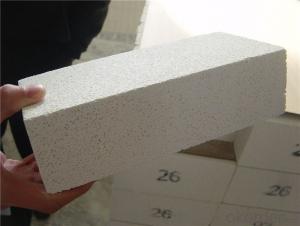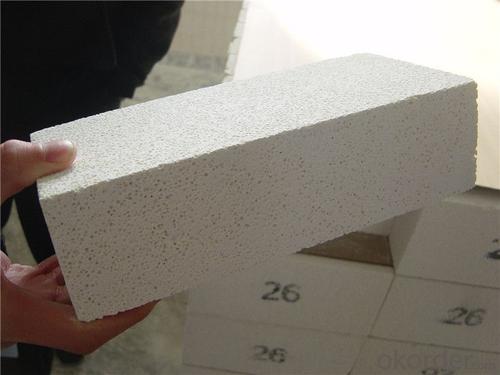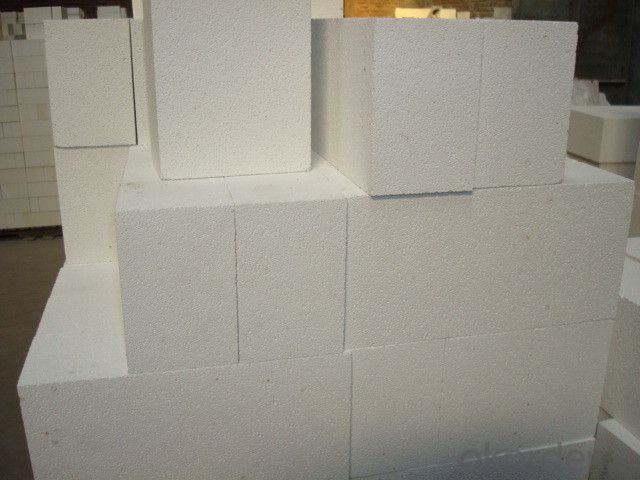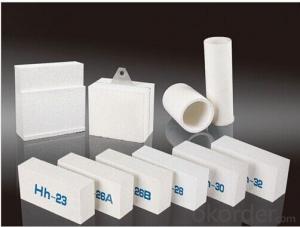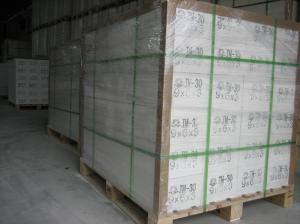Insulating Fire Brick - Insulating Brick, Insulation Brick, Mullite Brick
- Loading Port:
- Shanghai
- Payment Terms:
- TT OR LC
- Min Order Qty:
- 1 m.t.
- Supply Capability:
- 1000 m.t./month
OKorder Service Pledge
OKorder Financial Service
You Might Also Like
CNBM conforms strictly to the requirements of ISO 9000 quality control system during the production. MSDS is also available if you want. The thermal insulation fire clay brick meet with the requirements of ASTM & JIS standards. So please stay cool with our quality.
Application
Insulating Fire Brick are used for the lining of converter, alternating current arc furnace, direct Current arc furnace and the ladle slag line, etc.
Insulating Fire Brick Technical index
Brand Quality | JM23 | JM26 | JM28 | JM30 | JM32 | |
Bulk Density (g/cm3) | 0.52 | 0.78 | 0.88 | 1.03 | 1.25 | |
1.2 | 1.6 | 2.1 | 2.5 | 3.5 | ||
Modulus of Rupture (Mpa) | 0.9 | 1.4 | 1.6 | 2.1 | 2.1 | |
-0.5 | 1400℃ -0.4 | 1510℃ -0.5 | 1620℃ -0.9 | 1730℃ -0.9 | ||
Thermal Expansion 1100℃(%) |
0.5 |
0.7 |
0.8 |
0.9 |
1.1 | |
Thermal conductivity(W/m.k)
| 400℃ | 0.14 | 0.27 | 0.32 | 0.41 | 0.49 |
600℃ | 0.16 | 0.29 | 0.34 | 0.43 | 0.50 | |
800℃ | 0.18 | 0.31 | 0.36 | 0.44 | 0.51 | |
1000℃ | 0.20 | 0.33 | 0.38 | 0.45 | 0.53 | |
Al2O3 | 37 | 58 | 67 | 73 | 77 | |
Fe2O3 | 0.7 | 0.7 | 0.6 | 0.5 | 0.4 | |
Equipment
1 unit of Ceramic Abrasive (SG Abrasive) pilot production line
2 units of Compact grain Abrasive pilot production lines
1 unit of high-end coated abrasives (abrasive cloth) production line
2 units of Boron Carbide production lines
3 large flexible crushing and sieving lines for grit production lines
2 units of 2000KVA furnaces for Boron Carbide fusion
6 units of 5000KVA-10000KVA dumping type electric arc furnaces for Brown Fused Alumina fusion
Company Advantage
(1)Long Insulating Fire Brick manufacture history: 25 years manufacturer
(2)Advanced equipment
(3)Diversification of production standards: ISO ANSI FEPA JIS ASTM
(4)Flexible payment: T/T L/C D/P D/A
(5)Professional marketing team and after-sale service
(6)Free sample

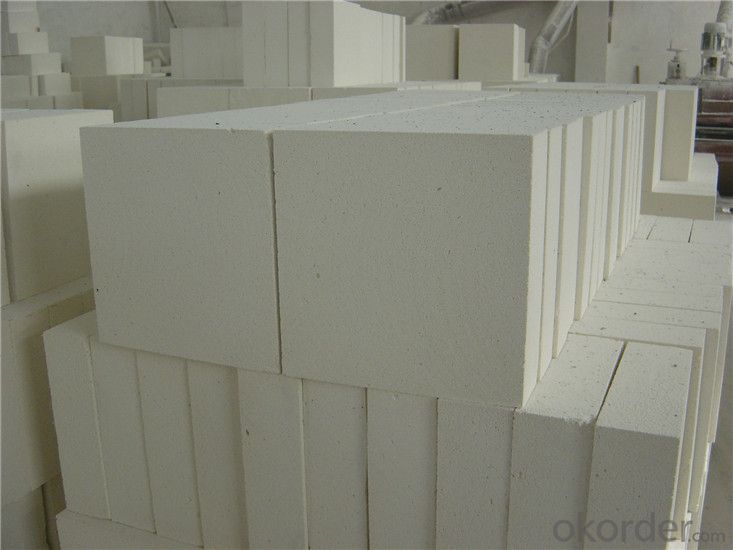
- Q: Do insulating fire bricks require any curing or drying time?
- No, insulating fire bricks do not require any curing or drying time. These bricks are manufactured using high-temperature processes, which results in a product that is already fully cured and dried. This means that they can be used immediately after installation without the need for additional curing or drying time.
- Q: How do insulating fire bricks help reduce fuel consumption?
- Insulating fire bricks help reduce fuel consumption by providing excellent thermal insulation, which minimizes heat loss and increases the efficiency of the heating system. This means that less fuel is required to maintain the desired temperature, resulting in reduced fuel consumption and cost savings.
- Q: Can insulating fire bricks be used in paper mills?
- Yes, insulating fire bricks can be used in paper mills. Insulating fire bricks are commonly used in industries that require high-temperature insulation, such as steel, glass, and ceramics. In paper mills, where processes like drying, heating, and burning occur, insulating fire bricks can be used to line kilns, furnaces, and other equipment to provide insulation and prevent heat loss. These bricks have excellent thermal insulation properties and can withstand high temperatures, making them suitable for use in paper mills where heat is a crucial component of the manufacturing process. Additionally, insulating fire bricks are lightweight and have low thermal conductivity, allowing for efficient heat retention and energy savings.
- Q: Do insulating fire bricks have a low thermal expansion rate?
- Yes, insulating fire bricks generally have a low thermal expansion rate. These bricks are designed to withstand high temperatures and thermal shocks, and one of their key properties is their ability to maintain their shape and dimensions under extreme heat conditions. Insulating fire bricks are made from materials that have a low coefficient of thermal expansion, meaning they expand and contract minimally when exposed to changes in temperature. This low thermal expansion rate ensures that the bricks remain stable and do not crack or break due to thermal stress. Additionally, the low thermal expansion rate of insulating fire bricks allows for better insulation performance, as it minimizes the gaps that can form between the bricks when they expand and contract, reducing heat loss and increasing energy efficiency.
- Q: Are insulating fire bricks suitable for use in high-temperature chimneys?
- Yes, insulating fire bricks are suitable for use in high-temperature chimneys. These bricks are specifically designed to withstand extreme temperatures and provide excellent insulation properties. They have a high melting point and low thermal conductivity, which allows them to effectively retain heat and prevent it from escaping through the chimney walls. This helps in maintaining a high temperature inside the chimney, which is crucial for efficient combustion and proper functioning of the chimney. Additionally, insulating fire bricks are lightweight and durable, making them an ideal choice for constructing chimneys that are exposed to high temperatures.
- Q: Can insulating fire bricks be used in the construction of industrial dryers?
- Industrial dryers can utilize insulating fire bricks, which are specifically designed to have low thermal conductivity. This allows them to retain heat and prevent heat loss, making them an ideal option for applications that require high temperatures. These fire bricks are created using lightweight materials like clay, silica, and alumina, and can withstand temperatures of up to 3000°F (1650°C). They possess exceptional insulation properties, leading to reduced energy consumption and improved efficiency for the industrial dryer. Moreover, insulating fire bricks are highly resistant to thermal shock, meaning they can endure sudden temperature changes without cracking or breaking. This quality is particularly crucial in industrial dryer settings where temperature fluctuations can occur rapidly. In conclusion, insulating fire bricks are a suitable choice for constructing industrial dryers due to their low thermal conductivity, resistance to high temperatures, and ability to withstand thermal shock.
- Q: Can fly ash brick keep warm?
- Add blocks and have autoclaved fly ash bricks, do not you?
- Q: How thick should the insulation layer be when using insulating fire bricks?
- The thickness of the insulation layer when utilizing insulating fire bricks relies on several factors, including the desired level of insulation, the surrounding environment's temperature, and the insulation's specific application or purpose. Generally, insulating fire bricks are engineered to deliver exceptional thermal insulation, effectively reducing heat transfer. However, the thickness of the insulation layer should be determined according to the project's specific requirements. For applications requiring high-temperature insulation, it is typically recommended to use a thicker layer of insulating fire bricks. This is because a thicker layer can provide superior insulation and more effectively minimize heat loss. Furthermore, a thicker insulation layer can enhance the overall structural integrity of the insulation system. Conversely, in cases where lower temperature insulation is necessary or when there are space limitations, a thinner layer of insulating fire bricks may suffice. It is essential to consider the thermal conductivity properties of the insulating fire bricks being utilized and ensure that the desired insulation requirements are met. It is important to note that insulation standards may differ based on local building codes, safety regulations, and industry norms. Therefore, it is advisable to seek guidance from professionals or experts in the field to determine the optimal thickness of the insulation layer when using insulating fire bricks for a specific project.
- Q: Can insulating fire bricks be used in ceramic kilns?
- Yes, insulating fire bricks can be used in ceramic kilns. Insulating fire bricks are designed to have low thermal conductivity, which means they are able to retain heat more effectively. This makes them an ideal choice for lining the walls of a kiln, as they help to conserve and distribute heat more evenly throughout the kiln chamber. Additionally, insulating fire bricks are lightweight and have a high resistance to thermal shock, which makes them durable and able to withstand the high temperatures typically reached in ceramic kilns.
- Q: Are insulating fire bricks fire-rated?
- Indeed, insulating fire bricks possess fire-rating. They are purposefully crafted to endure elevated temperatures and furnish superior thermal insulation in diverse applications. Fashioned from a distinct ceramic material with minimal thermal conductivity, these bricks possess the capability to retain heat and impede its transmission to the surroundings. Such attribute endows them with remarkable fire resistance, thereby safeguarding the structures they are employed in. Commonly employed within furnaces, kilns, fireplaces, and other environments characterized by high temperatures, insulating fire bricks play a pivotal role in ensuring fire protection.
Send your message to us
Insulating Fire Brick - Insulating Brick, Insulation Brick, Mullite Brick
- Loading Port:
- Shanghai
- Payment Terms:
- TT OR LC
- Min Order Qty:
- 1 m.t.
- Supply Capability:
- 1000 m.t./month
OKorder Service Pledge
OKorder Financial Service
Similar products
Hot products
Hot Searches
Related keywords
